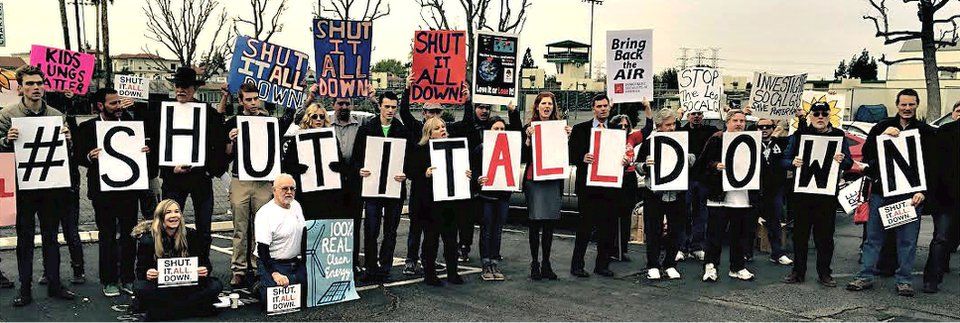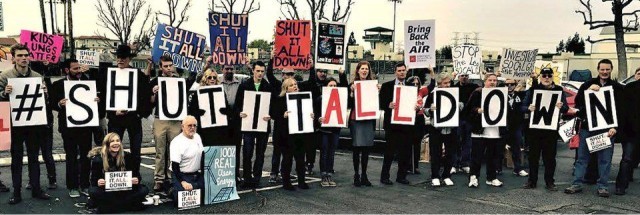



Residents of the nearby Porter Ranch neighborhood have suffered headaches, vomiting, heart palpitations, shortness of breath and nosebleeds. Nearly 3,000 have evacuated their homes, and 2,000 more are in the process. Two schools have had to close. California Gov. Jerry Brown, after 11 weeks of inaction, has declared a state of emergency, and the Federal Aviation Administration has taken the unusual step of declaring the area a no-fly zone.
When methane rises into the atmosphere, it traps the sun’s heat 25 times as efficiently as carbon dioxide. It is the second-biggest contributor to global warming. This leak has been called the worst environmental accident since the BP oil spill in the Gulf of Mexico in 2010.
Health dangers on top of environmental ones
Gas company officials have dismissed claims of illness and assert that methane, also known as natural gas, is harmless in the atmosphere. The symptoms reported so far are from mercaptan, an additive that emits the smell of rotten eggs and allows people to detect the otherwise undetectable gas. But natural gas also contains benzene, a known carcinogen. Warnings have been issued about prolonged exposure for oil workers, but not enough study has been done to determine what dangers might be posed by exposure to leaks like this one.
Aliso Canyon is the largest methane reservoir in the West and one of the largest in the country. Southern California Gas, which owns and operates the facility, has tried seven times to plug the leak and now says it has to drill two relief wells 8,700 feet below the surface, which will take three to four months.
The company is a de facto monopoly. It owns three other reservoirs in southern California and has no competitors because of a 2003 legal maneuver agreed to by the Public Utilities Commission. It is a subsidiary of Sempra Energy, the largest natural gas utility in the United States and a major force in international markets, with profits of $11 billion in 2014.
The scope of the disaster was well known by the time of November’s climate conference in Paris. Gov. Brown attended the conference as a climate change crusader, uttering not a word about the Porter Ranch well rupture. Brown’s family has old ties to oil and gas interests, and he inherited a stake in the family business.
The Brown administration has been more than friendly to California’s energy billionaires. In the last few years Brown has accepted $1.72 million in donations from the energy industry. Two weeks before the Aliso Canyon crisis, he appointed an oil executive to regulate the state’s oil industry. And he has been silent about the fact that his sister, Kathleen Brown, is a paid board member of Sempra Energy, drawing a $188,000 annual salary.
The federal government leaves regulation of natural gas up to the states. California has virtually no regulations for construction or maintenance of natural gas facilities. The decrepit state of the reservoir at Aliso Canyon is typical of the state’s dozen reservoirs. Built in 1953 as an oil reservoir, it was converted after 20 years into a natural gas facility and has not been updated since.
Had a safety valve been in place in 2015, it might have relieved some of the pressure and made it possible to plug the leak. But after such a valve broke in 1979, it was removed and bypassed by the company instead of being replaced. No federal or state regulation said it had to be there.
Capitalism is a recipe for environmental crises. The agencies supposed to ensure safety and transparency are a sham and provide high-paying jobs for worthless bureaucrats. Politicians like Jerry Brown depend on corporations for their political fortune.
Sempra Energy will fight tooth and nail to continue making profits regardless of the consequences to health and safety. And it’s not the only one. In southern California many oil wells are situated close to residential neighborhoods.
Grass-roots struggle breaks media silence
Every step forward since the Porter Ranch leak has happened because of grassroots struggle. Activists in both Food and Water Watch and Earthworks created a video, finally shown on the news, that uses an infrared, time-lapse technique to make visible the gas leaking from the well. FWW has also worked hand in hand with community group Save Porter Ranch to canvass neighborhoods, push for evacuations, organize rallies and generate 1,800 phone complaints about the health symptoms and odor. They also pushed the Air Quality Management Board to hold hearings to consider shutting down the Aliso Canyon facility completely.
On Jan. 9, some 300 people gathered outside the high school where the first hearing was being held. They rallied and then packed the meeting hall. Nalleli Cobo, a 15-year-old student, told the rally: “I lived in South Central in front of an oil site called Allenco whose toxic emissions made us sick. I suffered nosebleeds, headaches, stomach pain, heart palpitations and I developed asthma. I realized my community was sick as well. Porter Ranch and my community have a neighbor that doesn’t belong.”
After a news white-out, the consequences of the Porter Ranch disaster are now being closely followed by the capitalist media, thanks to the pressure of activists. No one knows how many more crises are in the making. Only united struggles by the people and communities most affected by capitalist chaos can ensure that health and safety are top priorities.
Special to Workers World The following is a press release issued on April 24, 2025,…
dear Larry Krasner, we heard you sued Elon Musk over his corrupt million election giveaways…
Unions join forces against harassment and deportation of members When 200 immigrant workers – from…
Larry Holmes First Secretary Workers World Party Dear Comrade, Under the assignment of the Central…
Download the PDF Black and white version All out for May Day! Students defend pro-Palestine…
By Jonas, Mutual Aid Scientific Socialism To the workers and free peoples of the world: We…